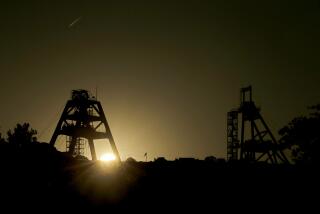Mining Pact Reverses Historic Policies : Congress: The industry-backed bill would let U.S. collect royalties for first time. Critics condemn the payments as too low.
WASHINGTON — Drawing little attention amid the broader federal budget debate, members of the House and Senate, backed by key figures in the mining industry, have carved out a far-reaching agreement that reverses policies and payment practices that have governed mining on public land for more than a century.
Under the new provision, the federal government would for the first time collect royalties on gold, silver, lead, platinum and other hard-rock minerals extracted from federal property.
Using figures developed by the Congressional Budget Office, critics say the royalties--5% on net profits, rather than on the value of the ore--would generate $1.7 million annually on mineral production worth $650 million. This would amount to about one-quarter of 1% of the value of the ore.
The measure, inserted into a massive budget bill adopted by both houses Friday, is supported by an alliance of mine operators and others tied to the mineral extraction industry. Critics consider it a major victory for mining interests.
In addition to arguing that the royalty payments would be too low, the critics also argue that the price a mine developer would pay to the federal government for the land, known as the “patent,” would be based on the land’s surface value rather than on the anticipated price of the valuable minerals that are mined.
Critics are characterizing the provision as a “sham reform” and a “federal giveaway.” Proponents are describing it as “responsible reform.” President Clinton already has threatened to veto the budget bill if it contains the measure.
The legislation goes to the heart of a continuing and often fiery debate over how much the federal government should be paid for the minerals buried in the vast lands it owns, mostly in the West. Public land accounts for approximately one-fifth of all land mined by private companies in the United States.
Those payments are governed by a law passed in 1872 that is widely seen as in need of updating. Interior Secretary Bruce Babbitt has complained that the 123-year-old law forces him to sign “patent” papers that allow international mining firms to gain access to the gold and other minerals at fees of $2.50 to $5 an acre.
Two months ago, as he completed the process that gave a Danish mining company, for a fee of $275, access to federal land believed to hold more than $1 billion in minerals, Babbitt said it was time for Congress to end the “flagrant abuse of the public interest.”
A year ago, when Democrats held majorities in the House and Senate, an attempt to overhaul the mining law broke down in Congress amid accusations that mining companies were pressuring Western senators to oppose any change in the 19th-Century law.
The minuscule fees were intended by the federal government to encourage development of Western resources.
The issue puts Clinton in a curious political position.
The political support he gained three years ago in the West was rare for a Democrat and helped him defeat George Bush.
Clinton, however, quickly fell into disfavor in the West over a regional issue--Babbitt’s unsuccessful effort to raise grazing fees--and such national issues as the Administration’s support for a ban on assault weapons.
Into this mix comes the mining issue, wrapped in economic and environmental disputes.
Mining companies, which play significant roles in local economies across the West, strongly favor the legislation.
But a wide swath of environmental organizations favors stricter controls over mining in general and is upset over the failure to enact higher fees for the use of public grazing land.
Their support is considered important nationally to the President’s reelection drive.
Jim Lyons, vice president of the Mineral Policy Center, which calls itself a public-interest organization made up of community groups and supported by donations, said in an interview the legislation would allow a Canadian company, American Barrick Co., to mine a 2,000-acre region of Nevada for a payment to the government of $5,190.
But Jack Gerard, a Washington representative of the Mineral Resources Alliance, made up of mining companies and suppliers, said complaints that the mining industry could deduct labor and other costs before being assessed the royalty payments did not take into account such non-deductible costs as those paid to lobbyists and lawyers, among other expenses linked to developing a mine.
Barrick, for example, has already invested $1 billion in the Nevada site, which is said to contain gold valued at $10 billion, before extracting any ore, Gerard said.
More to Read
Sign up for Essential California
The most important California stories and recommendations in your inbox every morning.
You may occasionally receive promotional content from the Los Angeles Times.










